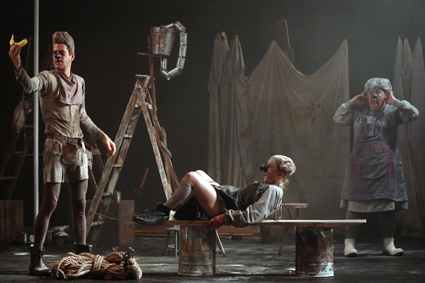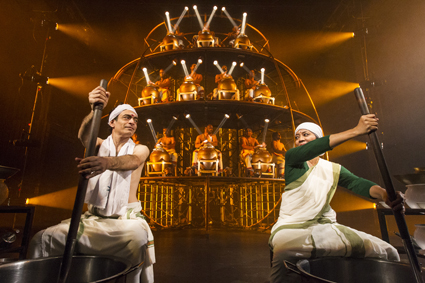Slippery when whet
Felicity Clark, The Long Pigs & The Kitchen

The Long Pigs
photo Prudence Upton
The Long Pigs
A wordless drama exploring the ritual of cooking and a silent slapstick rort about the darker side of clowning are both entertaining; neither entirely tasteful. The Long Pigs aims to upset and does so superbly, while The Kitchen provides a garish divertissement that is formulaic save for its well-structured thematic circularity and glorious evocation of Indian tradition
The Long Pigs
Physical theatre supergroup with particularly black humour, WE3, bring The Long Pigs to Sydney Festival. These sooty-nosed clowns aren’t quite right. WE3’s regalia is shabby, like their innocence. Their dirty little hands are conspiring, selfish, gluttonous, cannibalistic and animal: they’re in a pig-eat-pig world where exclusion, derision and brutality get you places. Caught between their mundane reality with its status quo security, and a forbidden fantasy of colour and joy, the three clowns non-verbally quest for mental and physical sustenance. Slippery bananas, a clowning stock-standard, come to represent not only humiliation but human meat (“long pig” is Melanesian Pidgin for human flesh). Bananas are the currency that affords these sorry souls survival. Every banana is a life; well, the life of a joke.
The wide stage is set like an abattoir or dusty factory. Shadowy clumps dangle from the ceiling like carcasses shrouding forgotten furniture. Silly-walking industrial underlings shuffle in to go about their repetitive, drab and nonsensical business. This factory routine, a meta-jab at comedy, is merciless. Jesting calls for freshness amid stale replication and these clowns know it, mock it and yet live it.
Nicci Wilks, Clare Bartholomew and Derek Ives-Plunkett make up the paranoid and disenfranchised comic trio. Director Susie Dee, along with set-designer Anna Tregloan and lighting guru Andy Turner bring the wags’ inner workings into a spatial concept. It’s Jethro Woodward’s engaging score though that balances macabre with ludicrous, synchronising intent with action.
So much is mysterious and left so. Why are these grim buffoons manufacturing—or is it murderously collecting—red noses? Are they feeding them to something? Do they work together or against each other? Their satire scissors at Judeo-Christian sanctimony and uses the divide between black- and red-noses as a metaphor for racism. They even deride the entertainment industry when they clamber into the audience to take payments from patrons who might like to stone Jesus (who is crucified on stage) from their seats. Violence is okay when it’s funny, and it’s even more okay when you pay good money for it.

The Kitchen
photo Jamie Williams
The Kitchen
The Kitchen
Roysten Abel’s non-narrative, non-verbal theatre work, The Kitchen, is highly dependent on symbolism: it combines on-stage cooking of Indian sweet Payasam (warm milk with rice, nuts, raisins and spices) with live musical accompaniment. It’s a sensory smorgasbord that delights smell and taste, especially when upon exiting the audience sample the dessert.
Twelve Kalamandalan drummers are perched on a copper kettle-shaped scaffold, with only their hands and drumskins lit. The effect is of cooking flames licking and lapping epicurean rites. Their collective sound thuds euphoniously but twangier solos cut through the air which is at most times balmy with cooking smells and billowing steam. In front of the drummers two actors (Mandakini Goswami and Dilip Shankar) prepare Payasam silently in near unison, their individual timing representative of our quirks and misalignments in love and compromise.
Director Abel, inspired by the Sufi mystic Rumi, says of the two pot-stirrers, “Even though they don’t act in the usual sense, they make an emotional journey during the performance. There is no real plot, but you get to see pieces of their story, the manner in which their relationship develops” (program note). After ghee and sugar, they pour in milk and once the milk-bowls are drained the actors rehearse their pouring actions from now empty vessels in a deeply sensual allusion. Like romance, it is the beautiful ache of longing, or lack, which makes union so sweet. Through cooking, the pair pass through infatuation, irritation, reconciliation, acceptance, devotion, boredom and many other emotional states in vignettes familiar to lovers.
In Hindu mythology, the human body is considered to be a kettle that holds the soul. Hence cooking holds potent metaphors for bodily and social transformations. Kettle shapes recur in The Kitchen, theming set design, action and even the bodies of the accompanying mizhav drums. Mizhav (small-headed copper or clay kettle drums common in Kerala’s temples) are traditionally heard in life rites like Namakaranam (naming ceremony), Upanayanam (boy’s introduction to education) and cremation. They’re associated with Brahmacharya (purity of sexual intent, often chastity or fidelity). Due to their place in pivotal life celebrations, each mizhav is treated with the status of a person—for example when the instrument wears out it is given a dignified burial. These associations make the mizhav the perfect accompanist for this dramatic presentation of relationship rituals, themselves microcosms of initiation and death.
The Kitchen’s symbolism is tidy and recursive, but it relies on associations with honorable traditions—Rumi’s take on love and hypnotic, ecstatic drumming—to add gravitas to the work’s banal showiness. Its most beautiful elements felt like justification for pleasing an audience out to taste-test sensuous entertainment this summer.
Sydney Festival; The Long Pigs, performer-devisors Derek Ives-Plunkett, Clare Bartholomew, Nicci Wilks, director Susie Dee, Everest Theatre, Seymour Centre, 15-18 Jan; The Kitchen, direction, lighting Roysten Abel, set design Neeraj Sahay, York Theatre, Seymour Centre, Sydney, 22-25 Jan
RealTime issue #125 Feb-March 2015 pg. 17






